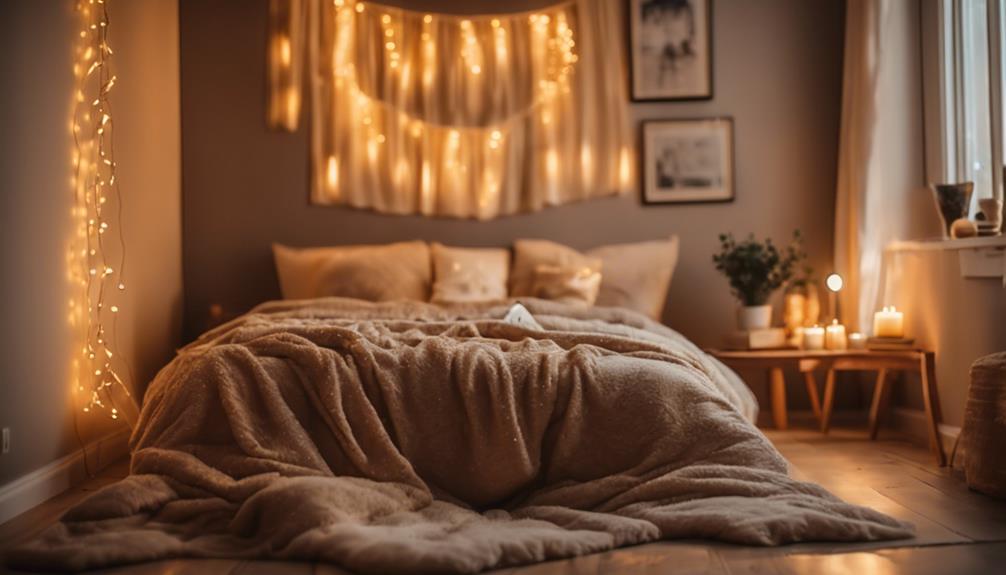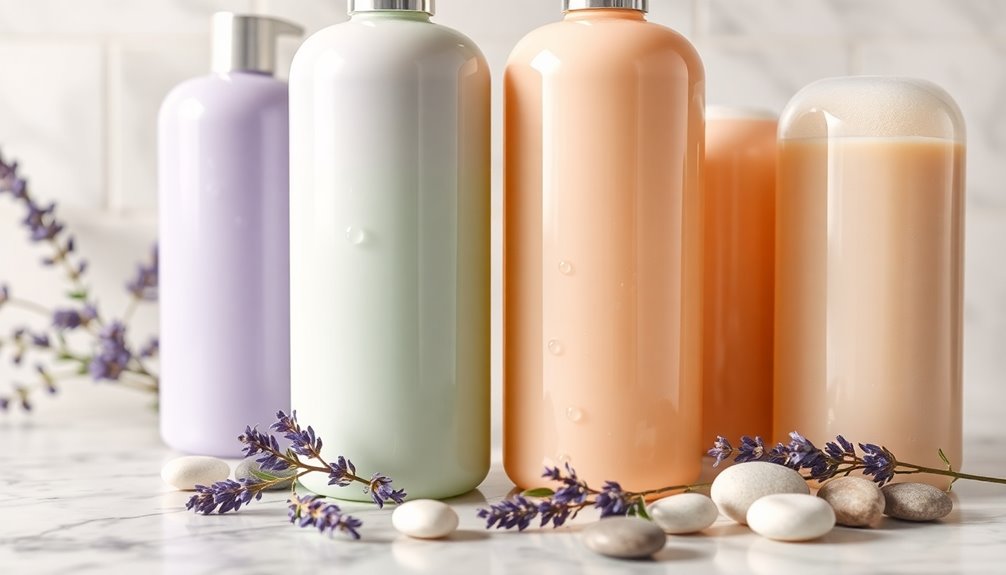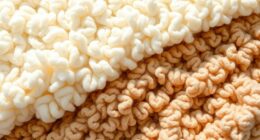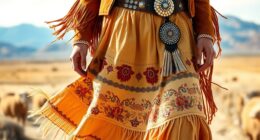If you’re interested in sustainable fashion, I’ve discovered 15 excellent books that are worth exploring. Titles like “Sustainable Fashion: What’s Next?” offer a variety of perspectives from industry experts, while “Fashionpedia” acts as a visual guide covering essential materials and techniques. Each book highlights the significance of eco-friendly practices, ethical labor, and responsible consumption. They break down complex subjects in an easy-to-understand manner, offering practical advice for both consumers and creators. These resources help clarify the complexities of sustainable fashion, making it simpler to make informed decisions. You’ll uncover valuable insights that can enrich your journey towards a more eco-conscious wardrobe.
Key Takeaways
- "Sustainable Fashion: What's Next?" provides insights from industry professionals on future practices and challenges in sustainable fashion.
- "Fashionpedia" serves as a visual dictionary, aiding understanding of style, materials, and techniques used in sustainable fashion.
- Literature on sustainable fashion increases awareness of ethical practices and promotes responsible consumption by highlighting sustainable brands.
- Books often offer practical care advice to extend garment lifespan, helping reduce waste and promoting eco-friendly consumer habits.
Sustainable Fashion: Responsible Consumption and Design

For anyone looking to make informed choices in their wardrobe, the best books on sustainable fashion offer essential insights into responsible consumption and innovative design practices.
I've found that sustainable fashion emphasizes the need for eco-friendly materials and ethical production methods. By understanding these principles, I can make better decisions about my clothing purchases.
Responsible consumption means selecting brands that prioritize fair labor practices and minimal environmental impact. It's clear that consumers now expect transparency from fashion brands, pushing them to adopt more sustainable practices.
Additionally, innovative production methods, such as utilizing recycled materials, play a crucial role in reducing the fashion industry's ecological footprint.
Overall, these books provide valuable knowledge that helps me navigate the complex landscape of sustainable fashion effectively.
Best For: Individuals seeking to make environmentally responsible choices in their wardrobe through informed purchasing decisions.
Pros:
- Increases awareness of ethical practices and sustainable materials in the fashion industry.
- Encourages responsible consumption by promoting brands that prioritize fair labor and minimal environmental impact.
Cons:
- May require more research to identify truly sustainable brands among misleading marketing claims.
- Potentially higher costs associated with purchasing ethically produced fashion items.
Sustainable Fashion: What's Next? A Conversation on Practices and Possibilities

Readers passionate about the intersection of fashion and environmental responsibility will find 'Sustainable Fashion: What's Next?' to be an insightful guide that sparks meaningful conversations about future practices and possibilities in the industry.
This book offers a thorough exploration of sustainability, addressing challenges and opportunities through essays by industry professionals and academics. It emphasizes important themes like organic production, humane working conditions, and recycling, while also discussing the role of technology in sustainability.
The second edition expands on design processes and contemporary issues, making it highly relevant. Practical advice for consumers fosters a sense of responsibility, encouraging individual contributions to sustainability.
Overall, this book is an essential resource for anyone interested in the evolving dynamics of sustainable fashion.
Best For: Readers passionate about sustainable fashion and environmental responsibility looking to deepen their understanding of the industry's challenges and opportunities.
Pros:
- Diverse Perspectives: Features essays from industry professionals and academics, providing a well-rounded view of sustainability in fashion.
- Practical Guidance: Offers actionable advice for consumers to adopt sustainable practices in their clothing choices.
Cons:
- Complex Concepts: Some readers may find the philosophical discussions on sustainability challenging to grasp.
- Limited Accessibility: Certain educational resources may require separate access, potentially limiting engagement.
Fashionpedia – The Visual Dictionary Of Fashion Design

Fashionpedia stands out as an essential resource for fashion students and professionals, offering a wealth of visual information on style, materials, and production techniques.
This visual dictionary is tailored for anyone interested in fashion, from students to hobbyists. The book features detailed illustrations and infographics that make complex concepts accessible and easy to understand.
I appreciate its A5 size, which makes it portable and convenient for reference. Covering a broad range of topics, including history, styles, and techniques, it serves as a valuable guide for those looking to enhance their fashion knowledge.
Many users recommend Fashionpedia for its high-quality materials and extensive content, making it a must-have for anyone in the fashion industry or aspiring to enter it.
Best For: Fashion students, professionals, and enthusiasts seeking a comprehensive visual reference for style, materials, and production techniques.
Pros:
- High-quality illustrations and infographics that simplify complex fashion concepts.
- Portable A5 size makes it convenient for on-the-go referencing.
Cons:
- May be too technical for casual readers with limited fashion knowledge.
- A5 size might not provide enough detail for advanced designers seeking in-depth information.
The Worm Book For Beginners: 2nd Edition

Aiming to simplify vermiculture for novices, 'The Worm Book For Beginners: 2nd Edition' is perfect for anyone enthusiastic to transform kitchen scraps into rich compost while embracing sustainable living.
This engaging guide covers essential steps to set up and maintain a worm farm, making it accessible for beginners. It provides clear instructions on creating ideal conditions for worms and harvesting nutrient-rich compost.
The book also addresses common concerns, like pest management and worm health, easing the anxiety of new users. By promoting vermicomposting as an eco-friendly alternative to chemical fertilizers, it encourages readers to recycle food waste effectively.
Overall, this resource is a valuable starting point for anyone looking to adopt sustainable gardening practices.
Best For: Beginners and moderate-level gardening enthusiasts looking to start vermicomposting and reduce kitchen waste.
Pros:
- Engaging and accessible introduction to vermiculture for novices.
- Step-by-step guidance on setting up and maintaining a worm farm.
Cons:
- May be considered too basic for advanced readers seeking in-depth information.
- Limited illustrations and visuals that could enhance understanding.
Womens Fashion and the Gender Equality Movement (SERIES: FASHION Book 1)

For anyone passionate about the intersection of women's fashion and the gender equality movement, 'Womens Fashion and the Gender Equality Movement (SERIES: FASHION Book 1)' is an essential read that illuminates the historical and contemporary shifts shaping this vibrant dialogue.
The book explores how women's fashion has evolved from restrictive garments in the Middle Ages to practical clothing during the Enlightenment, reflecting broader societal changes.
It highlights the significant impact of the World Wars and the feminist movements of the 1960s and 1970s, as women embraced pants as symbols of empowerment.
Today, fashion serves as a platform for diverse identities, promoting inclusion and challenging traditional norms.
This book effectively connects the dots between fashion and women's rights, showcasing their intertwined evolution.
Best For: Individuals interested in understanding the evolution of women's fashion and its relationship with the gender equality movement.
Pros:
- Comprehensive Historical Insight: The book provides a thorough exploration of women's fashion throughout history, highlighting key societal changes.
- Connection to Feminist Movements: It effectively links fashion trends to significant feminist movements, illustrating their impact on women's rights.
Cons:
- Limited Focus on Global Perspectives: The book primarily addresses Western fashion trends, which may overlook important global influences in women's fashion.
- May Feel Academic: Some readers might find the writing style too scholarly or dense for casual reading.
Fashion and Color Psychology: The Emotional Impact on Clothing

Those seeking to understand the deep emotional connections between clothing and color will find the 'Best Books on Sustainable Fashion' invaluable in exploring how these elements intersect.
Colors play a pivotal role in fashion, influencing perceptions and emotions. For instance, red embodies passion and energy, while blue promotes tranquility and trust.
Our clothing choices often reflect our personality; warm colors suggest extroversion, whereas cool colors indicate a more introspective nature. Additionally, colors can also serve as nonverbal cues, conveying messages without words.
In practical terms, aligning colors with our moods can enhance feelings of confidence and authenticity. By experimenting with different combinations, I can express myself more fully through fashion while considering the psychological impact of my choices.
Best For: Individuals interested in exploring the emotional and psychological aspects of fashion through color, enhancing their self-expression and confidence.
Pros:
- Pros: Offers insights into how color choices can reflect personality traits and emotional states.
- Pros: Provides practical tips for using color to enhance mood and confidence in daily outfits.
Cons:
- Cons: May require a deeper understanding of color theory, which can be overwhelming for some.
- Cons: Information may not be applicable to everyone, as personal preferences and cultural contexts vary.
The Return of Vintage Fashion: A Conscious and Stylish Return (Fashion Book 1)

Reviving vintage fashion not only allows me to express my unique style but also supports sustainable practices by reducing waste and promoting ethical consumption.
Vintage pieces, typically over 20 years old, reflect the distinctive aesthetics of their respective decades, from the elegant silhouettes of the 20s to the bold prints of the 70s. By choosing these durable and high-quality garments, I contribute to a more sustainable fashion cycle, minimizing the impact of fast fashion on the environment.
I find vintage fashion offers a diverse range of styles that cater to various tastes, ensuring there's something for everyone.
I often source these treasures from thrift stores, antique fairs, and online marketplaces. Engaging with communities on social media platforms also provides inspiration and tips for discovering unique vintage finds.
Best For: Vintage fashion enthusiasts seeking a sustainable and unique wardrobe that reflects personal style.
Pros:
- Promotes sustainability by reducing textile waste and the reliance on fast fashion.
- Offers diverse styles from various decades, catering to a wide range of fashion tastes.
Cons:
- Finding the right fit can be challenging since vintage sizing differs from modern standards.
- Condition can vary, requiring careful inspection and potentially costly repairs.
The Great Fashion Designers and Their Striking Creations (Fashion Book 1)

Fashion enthusiasts seeking to deepen their understanding of influential designers and their transformative creations will find 'The Great Fashion Designers and Their Striking Creations' an invaluable resource. This ebook explores the evolution of fashion, showcasing how creativity shapes identity, culture, and time. It highlights several visionary designers who revolutionized the industry with their innovative ideas.
I appreciate how the book details each designer's trajectory, illustrating their journeys and significant contributions. The distinctive styles are examined closely, emphasizing their impact on trends and future generations.
Additionally, readers can discover iconic creations that catapulted these designers into fame, revealing their lasting influence on both the fashion industry and cultural landscape. This book is essential for anyone wanting to understand fashion's rich history.
Best For: Fashion enthusiasts and students seeking to deepen their understanding of influential designers and their contributions to the fashion industry.
Pros:
- In-depth exploration of the evolution of fashion and its cultural significance.
- Detailed designer trajectories that highlight key contributions and innovative ideas.
Cons:
- May be too focused on historical aspects for readers seeking contemporary fashion insights.
- Some readers might find the depth of detail overwhelming if they are new to fashion studies.
Stories Behind the Most Famous Fashion Brands (SERIES: FASHION Book 1)

For anyone curious about the rich narratives that shaped the world's most iconic fashion brands, 'Stories Behind the Most Famous Fashion Brands' offers an engaging exploration of their unique journeys.
This ebook dives deep into the histories of renowned brands like Chanel, Dior, and Gucci, revealing how each brand has faced challenges and embraced innovations.
It highlights their significant impact on cultural norms and trends, showcasing how these fashion houses influence personal expression and societal standards.
By examining the intricate tales behind these labels, readers can gain a better understanding of the fashion landscape today.
This book serves as an insightful resource for anyone looking to appreciate the artistry and evolution of the fashion industry.
Best For: This ebook is best for fashion enthusiasts, students, and anyone interested in the history and evolution of iconic fashion brands.
Pros:
- In-depth exploration of the unique stories behind famous fashion brands.
- Insightful resource for understanding the cultural impact of fashion on society.
Cons:
- Limited scope as it focuses only on a select few brands.
- May not appeal to readers looking for practical fashion advice or styling tips.
The Fashion Icons that Marked the Era (SERIES: FASHION Book 1)
Exploring the transformative influence of fashion icons can inspire anyone passionate about sustainable fashion to rethink their approach and embrace new, eco-friendly styles.
Fashion icons serve as cultural touchstones, reflecting societal values and trends through their choices. They challenge established norms and redefine beauty standards, encouraging self-expression and creativity. By examining their legacies, I see how these influential figures have shaped the industry and sparked social debates about sustainability.
Their impact extends beyond personal style; it's about understanding the historical context that influences fashion. This knowledge helps me appreciate contemporary trends and guides my choices towards more sustainable options.
As I explore these icons, I'm reminded of the power of fashion to communicate identity while advocating for a more eco-conscious future.
Best For: Individuals passionate about sustainable fashion who seek inspiration from influential fashion icons to enhance their eco-friendly style choices.
Pros:
- Pros: Provides insight into the transformative power of fashion icons in shaping sustainable trends.
- Pros: Encourages self-expression and creativity through the exploration of diverse aesthetic choices.
Cons:
- Cons: May not address all aspects of sustainable fashion, focusing primarily on fashion icons.
- Cons: Some may find the emphasis on past figures less relevant to current sustainability practices.
A Guide to Building a Versatile and Timeless Wardrobe (Fashion Book 1)

Building a versatile and timeless wardrobe is ideal for anyone looking to simplify their style while making sustainable choices that stand the test of time.
A versatile wardrobe lets me create different looks with the same pieces, while a timeless wardrobe consists of classic items that remain stylish over the years. I focus on acquiring quality, well-cut pieces in neutral colors, as these form the backbone of my flexible wardrobe.
Proper organization is essential; it allows for easy access to vital items and facilitates outfit combinations.
I've learned to mix and match my pieces effectively, showcasing the versatility of my collection.
Finally, I make sure I take good care of my clothes, maintaining their quality and longevity, which ultimately makes my investment worthwhile.
Best For: Individuals seeking to simplify their style with classic pieces that offer versatility and longevity in their wardrobe.
Pros:
- Pros: Focuses on quality, ensuring items last for years.
- Pros: Encourages a minimalist approach, making outfit selection easier.
Cons:
- Cons: Initial investment in quality pieces may be higher.
- Cons: Requires regular organization and maintenance to maximize effectiveness.
Unisex Fashion and the Deconstruction of Gender: A Manifesto for Freedom of Expression

Unisex fashion champions freedom of expression, making it an essential read for anyone passionate about breaking gender barriers in style and embracing a more inclusive approach to personal identity.
The historical roots of unisex fashion emerge from 20th-century movements like feminism, which challenged traditional norms. This movement critiques rigid gender expectations, promoting the idea that clothing doesn't need to align with gender. Instead, it allows for individual expression, enabling people to explore personal style beyond predefined labels.
Unisex designs manifest in various ways, from neutral classics to innovative pieces that defy categories. Influential figures like David Bowie and brands like Hood by Air lead this change, paving the way for a more inclusive future where authentic self-expression thrives.
Best For: Individuals seeking to express their identity freely through fashion while challenging traditional gender norms.
Pros:
- Promotes inclusivity by allowing people of all gender identities to find styles that resonate with them.
- Encourages personal expression through a diverse range of clothing options that transcend conventional gender categories.
Cons:
- Potential confusion for consumers who are accustomed to traditional gendered clothing and may struggle to navigate unisex options.
- Limited availability of certain styles in mainstream retail, making it harder for some individuals to access unisex fashion.
The History of Shoes and Their Significance in Fashion: A Journey Through Time (Fashion Book 1)

For anyone interested in the rich narrative behind footwear, 'The History of Shoes and Their Significance in Fashion: A Journey Through Time' offers a compelling insight into how shoes have shaped and reflected our cultural identities throughout history.
This book traces the evolution of shoes from basic protective coverings to the intricate designs we see today. It highlights how shoes serve as symbols of identity and social standing, revealing insights about economic status and personal style.
The fashion influence of shoes is undeniable, with each era showcasing distinct trends that enhance aesthetics. Additionally, the book explores technological advancements that improve both functionality and comfort, illustrating how footwear adapts to societal changes while remaining an essential fashion element.
Best For: Anyone interested in the historical, cultural, and fashion significance of footwear, including fashion enthusiasts, historians, and cultural studies students.
Pros:
- Pros: Provides a comprehensive overview of the evolution of shoes across different cultures and time periods.
- Pros: Highlights the interplay between footwear design and societal changes, enhancing understanding of fashion history.
Cons:
- Cons: May be too focused on historical context for readers seeking practical fashion advice.
- Cons: Could lack detailed analysis of contemporary shoe brands and trends.
Simple Shapes Stunning Quilts: 100 designs to sew for patchwork perfection

Quilters at any skill level will find 'Simple Shapes Stunning Quilts' an invaluable resource, as it offers 100 designs that transform basic shapes into extraordinary patchwork creations.
Authored by Stuart Hillard, this book is organized into five pattern chapters, each with 20 unique quilts. The designs include one-patch quilts, strips and squares, triangles, curves, and foundation piecing.
Hillard provides clear instructions and essential techniques, making it easy for beginners to follow along. The book encourages personalization, allowing quilters to adapt designs through color choices and arrangements.
Additionally, it features practical tips and necessary tools for tackling quilting projects.
Overall, it's an all-encompassing guide that inspires creativity while catering to both novice and experienced quilters alike.
Best For: Quilters of all skill levels seeking inspiration and practical guidance to create stunning patchwork designs from simple shapes.
Pros:
- Clear, easy-to-follow instructions suitable for beginners and experienced quilters alike.
- Offers a wide variety of 100 unique quilt designs, encouraging creativity and personalization.
Cons:
- Some advanced quilters may find the designs too simplistic.
- Limited focus on complex techniques may not satisfy those looking for more challenges.
Mindless Eating: Why We Eat More Than We Think

Those looking to understand how our environment influences eating habits will find 'Mindless Eating: Why We Eat More Than We Think' an invaluable resource. This book reveals that we often overeat due to external cues, like larger dishes or the variety of food available.
I learned that distinguishing between physical and emotional hunger is essential; while physical hunger is gradual and satisfying, emotional hunger can lead to guilt.
The book offers practical strategies for mindful eating, such as using smaller plates and pre-plating meals to control portions. By becoming aware of the psychological factors behind our eating behaviors, I can make healthier choices.
Ultimately, small adjustments can lead to significant changes without feeling deprived.
Best For: Individuals seeking to understand the psychological and environmental factors influencing their eating habits and looking to adopt healthier eating practices.
Pros:
- Provides practical strategies for mindful eating, making it easier to control portions.
- Highlights the impact of environmental cues, enabling readers to make informed food choices.
Cons:
- May require significant self-awareness and effort to implement the suggested strategies effectively.
- Some readers might find it challenging to change deeply ingrained eating habits.
Factors to Consider When Choosing Books on Sustainable Fashion

When I choose books on sustainable fashion, I consider several key factors.
I look at the author's expertise and how relevant the content is to current trends in the industry.
It's also important to me that the book offers practical tips, showcases diverse perspectives, and has high visual and educational quality.
Author Expertise and Background
Considering the author's expertise and background can greatly influence the quality and relevance of the information presented in books on sustainable fashion. When I choose a book, I prioritize authors with solid experience in the fashion industry, especially those knowledgeable about eco-friendly practices, ethical production, and design innovation. This firsthand experience can provide valuable insights that mere theory cannot.
I also look for authors with academic credentials in fields relevant to sustainability, like environmental science or textile engineering. Such qualifications often enhance the credibility of the information they present.
Moreover, authors who've been involved with sustainable fashion organizations or initiatives usually offer practical applications of sustainable practices, making their work more applicable to real-world situations.
It's beneficial to evaluate whether the author has published other works or articles on similar topics. This can indicate a deeper commitment to sustainable fashion principles.
Relevance to Current Trends
I prioritize books on sustainable fashion that reflect the latest trends and consumer demands for transparency and ethical practices. With a noticeable rise in interest from younger demographics, it's essential to choose titles that tackle these contemporary issues.
I look for works that emphasize the importance of eco-friendly materials and innovative production methods, as consumers increasingly support brands that prioritize sustainability.
Books that investigate circular economy principles, such as recycling and upcycling, are particularly relevant. They align with the growing trend of reducing waste and promoting responsible consumption.
Furthermore, educational resources are gaining traction, helping readers understand the environmental impact of their clothing choices and fostering sustainable lifestyles.
I also seek out books that highlight collaborations and initiatives within the fashion industry, showcasing brands that are genuinely committed to evolving practices in response to consumer values.
By focusing on these aspects, I guarantee the books I select not only inform but also inspire positive change in the fashion landscape.
Ultimately, the relevance to current trends is a significant factor when I choose which sustainable fashion books to explore, ensuring they resonate with today's eco-conscious readers.
Practical Application and Tips
Choosing books on sustainable fashion should focus on practical advice that empowers readers to make informed choices and extend the lifespan of their clothing. When I look for these resources, I prioritize titles that provide actionable tips on garment care and maintenance. This advice not only helps me keep my clothes looking good longer but also promotes responsible consumption.
I also seek out books that explore innovative production methods and eco-friendly materials. Understanding the materials and processes behind sustainable fashion enhances my knowledge and equips me to make better purchasing decisions. Publications featuring case studies and real-world applications are particularly valuable, as they showcase successful sustainability initiatives within the fashion industry, making the concepts more relatable and practical.
Engagement is another critical factor. I prefer books that include discussion questions or reflection prompts, encouraging me to critically examine my consumption habits.
Diversity of Perspectives
Embracing a diversity of perspectives enriches the exploration of sustainable fashion, revealing its intricate connections to design, consumer behavior, and social justice.
When I choose books on sustainable fashion, I prioritize those that incorporate a variety of voices and viewpoints. This approach helps me understand how sustainability intersects with cultural, economic, and ethical issues within the fashion industry.
Books that include perspectives from marginalized communities often highlight the disparities faced in fashion production. These narratives shed light on the need for inclusive practices and equitable treatment, which are essential for a truly sustainable future.
In addition, engaging with different viewpoints fosters innovation, encouraging the exploration of alternative materials, production methods, and business models.
Visual and Educational Quality
Prioritizing visual and educational quality in sustainable fashion books guarantees a more engaging and informative experience for readers.
When I choose a book, I always look for those printed on eco-friendly materials, like FSC-certified paper. This choice aligns with sustainable practices and reflects the book's commitment to the cause. High-quality illustrations and infographics are also vital, as they help clarify complex topics related to sustainable fashion.
I appreciate educational resources like self-quizzes and videos, which enhance my learning experience and make the material more accessible. Additionally, books featuring real-world applications, such as case studies and professional profiles, provide practical insights into implementing sustainable practices in the fashion industry.
It's important that the content is organized clearly, covering key themes such as material choices, ethical production methods, and consumer responsibility. A well-structured book facilitates comprehension and keeps me engaged.
In my experience, books that excel in visual and educational quality not only enrich my understanding but also inspire action towards a more sustainable future in fashion.
Frequently Asked Questions
What Are the Best Beginner Books on Sustainable Fashion?
I've found great beginner books on sustainable fashion that really opened my eyes. Titles like “Fashionopolis” and “The Conscious Closet” helped me understand the importance of eco-friendly choices in our clothing and lifestyle.
How Can I Apply Sustainable Fashion Principles in My Wardrobe?
I've tried transforming my wardrobe into a sustainable utopia. I'm swapping fast fashion for thrifted gems, embracing minimalism, and even learning to sew. I might just become a fashion revolutionary—one mismatched sock at a time!
Are There Any Sustainable Fashion Books Focused on Children's Clothing?
I've found a few great books on sustainable fashion for kids. They offer practical tips for choosing eco-friendly materials and teaching children about ethical clothing choices. It's inspiring to see sustainability emphasized in children's wardrobes!
Which Authors Are Considered Experts in Sustainable Fashion Literature?
I've found that authors like Kate Fletcher, Lucy Siegle, and Clare Press are recognized as experts in sustainable fashion literature. Their insights really expand my understanding of eco-friendly practices and the industry's impact on our planet.
How Can I Support Sustainable Fashion Brands Mentioned in These Books?
I support sustainable fashion brands by researching their practices, purchasing from them directly, and sharing their stories on social media. I also prioritize thrift shopping to promote circular fashion and reduce waste in the industry.
Conclusion
In exploring these 15 essential books on sustainable fashion, I realized the stark contrast between fast fashion's impact and the thoughtful practices advocated in these texts.
Each book offers unique insights, from responsible consumption to the historical significance of fashion.
As I dive deeper into these ideas, I see a clearer path towards a more sustainable future.
By understanding these concepts, I can make informed choices that reflect both style and environmental responsibility.









